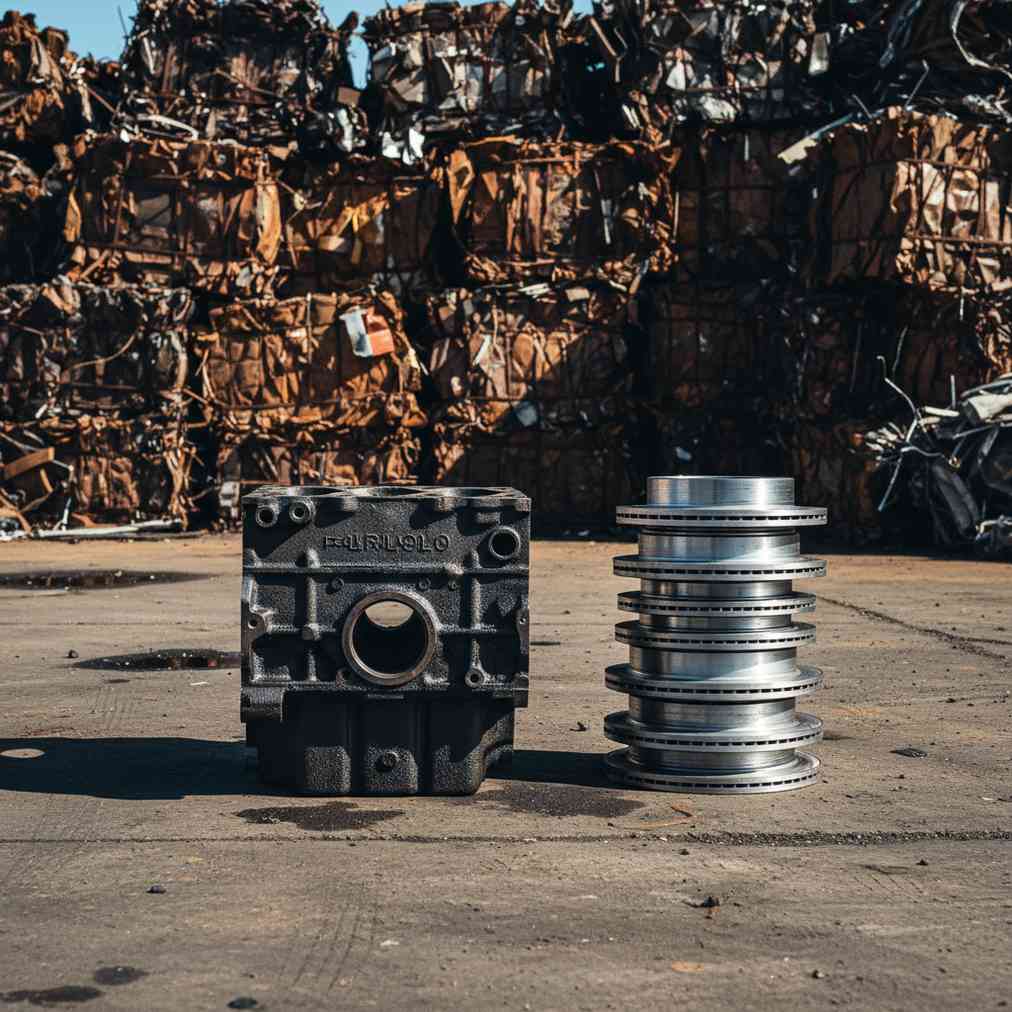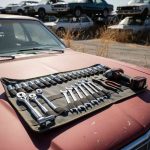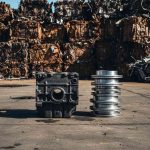Understanding the Economic Relationship Between Scrap Metal and Used Auto Parts
The automotive recycling industry operates on a complex economic model where fluctuating scrap metal prices directly influence the cost and availability of used auto parts. This intricate relationship affects everything from your local salvage yard’s inventory decisions to the final price you pay for that replacement transmission or engine.
When global commodity markets shift, the ripple effects reach deep into junkyards near me, creating a dynamic pricing environment that savvy consumers need to understand. The dual revenue stream model of salvage yards – selling both individual used parts and bulk scrap metal – creates fascinating economic tensions that ultimately determine what parts are available and at what cost.
The Dual Revenue Stream: How Salvage Yards Operate
Auto salvage yards generate income through two primary channels: selling used auto parts to consumers and mechanics, and selling scrap metal from stripped vehicle hulks to recycling facilities. This dual model creates a constant economic balancing act that influences every operational decision.
According to industry data analysis, the profitability equation changes dramatically based on commodity prices. When steel and aluminum prices surge, the residual value of a completely stripped vehicle can increase by 40-60%, fundamentally altering the yard’s processing priorities.
| Revenue Source | Typical Percentage of Total Revenue | Price Volatility |
|---|---|---|
| Used Parts Sales | 60-70% | Low to Moderate |
| Scrap Metal Sales | 30-40% | High |
High Scrap Metal Prices: The Crushing Incentive
When global steel and aluminum markets experience upward pressure, salvage yards face powerful economic incentives to accelerate vehicle processing. This phenomenon creates several cascading effects throughout the used parts ecosystem.
Operational Changes During Price Spikes
- Faster Processing Times: Yards prioritize quick parts removal and rapid crushing to capitalize on high scrap values
- Reduced Inventory Holding: Less incentive to keep vehicles for long-term parts sales when immediate scrap value is attractive
- Space Optimization: Quick turnover frees up valuable yard space for new inventory
- Cash Flow Acceleration: Immediate scrap sales provide faster liquidity than waiting for individual parts sales
These operational shifts have significant implications for consumers seeking specific parts. Popular salvage yards like LKQ Pick Your Part Houston may see reduced selection windows during high scrap price periods, as vehicles move through processing more quickly.
Impact on Parts Pricing and Availability
High scrap metal prices create an interesting economic floor effect. When the base metal value of a vehicle increases substantially, it supports higher pricing across all salvageable parts. This occurs because the opportunity cost of holding a vehicle for parts sales increases when scrap values are elevated.
“When scrap steel hits $400 per ton, every car in our yard becomes worth at least $200-300 just for metal content. That changes how we price everything from engines to door panels.” – Industry veteran salvage yard operator
Low Scrap Metal Prices: The Patient Approach
Conversely, when commodity markets experience downturns, salvage yard economics shift dramatically toward maximizing parts sales revenue. This creates a completely different operating environment with distinct advantages for consumers.
Extended Inventory Cycles
During low scrap price periods, yards like Pull-A-Part Knoxville often extend vehicle holding periods significantly. This strategic patience allows for:
- Maximum Parts Harvesting: More time to extract and sell valuable parts before scrapping
- Price Recovery Waiting: Holding scrap inventory until commodity prices improve
- Enhanced Consumer Selection: Larger available inventory for parts shoppers
- Competitive Pricing Pressure: Greater reliance on parts sales creates pricing competition
Research from statistical analysis experts indicates that consumer savings can increase by 15-25% during low scrap price periods due to these extended inventory cycles.
The Global Economics Behind Metal Price Fluctuations
Understanding the broader economic forces driving scrap metal prices helps consumers predict and plan for cost fluctuations in used auto parts markets. Several key factors influence these commodity cycles:
| Economic Driver | Impact on Scrap Prices | Effect on Parts Costs |
|---|---|---|
| Global Manufacturing Demand | Direct correlation | Moderate increase |
| Infrastructure Spending | Strong upward pressure | Significant increase |
| Energy Costs | Processing cost influence | Variable impact |
| Geopolitical Events | High volatility | Unpredictable swings |
| Chinese Economic Activity | Major price driver | Substantial influence |
The interconnected nature of global markets means that events seemingly unrelated to automotive recycling can have profound effects on local parts pricing. For instance, emerging AI and data science trends are increasingly being used to predict these market movements more accurately.
Strategic Timing for Parts Purchases
Savvy consumers can leverage their understanding of scrap metal cycles to optimize their parts purchasing strategies. Timing becomes crucial for both availability and pricing considerations.
Optimal Purchasing Windows
The best times to visit facilities like LKQ Pick-A-Part Ontario often correlate with broader economic cycles:
- Economic Recession Periods: Reduced manufacturing demand leads to lower scrap prices and better parts availability
- Winter Months: Construction slowdowns typically reduce steel demand
- Post-Holiday Periods: Manufacturing lulls can create temporary price dips
- Energy Price Spikes: High processing costs can temporarily depress scrap demand
Conversely, avoid major purchases during infrastructure boom periods, post-disaster reconstruction phases, or when emerging markets experience rapid industrialization, as these events typically drive scrap prices higher.
The Parts Hierarchy: What Gets Affected Most
Not all auto parts experience equal sensitivity to scrap metal price fluctuations. Understanding this hierarchy helps consumers prioritize their purchasing strategies:
High Sensitivity Parts
These parts contain significant metal content and are most affected by commodity price swings:
- Engine Blocks: High iron and aluminum content makes them sensitive to metal price changes
- Transmissions: Heavy steel construction creates direct correlation with scrap values
- Body Panels: Sheet metal parts see the most dramatic pricing variations
- Suspension Parts: Steel-heavy construction amplifies price sensitivity
When shopping for these parts at locations like Pick-N-Pull Sacramento, timing your visit during low scrap price periods can result in substantial savings.
Low Sensitivity Parts
These parts maintain relatively stable pricing regardless of commodity fluctuations:
- Electronic Modules: Value derived from functionality, not material content
- Interior Trim: Primarily plastic construction insulates from metal price changes
- Glass Parts: Different material base reduces correlation with steel/aluminum prices
- Rubber Parts: Petroleum-based materials follow different commodity cycles
Regional Variations in Price Sensitivity
The impact of scrap metal price fluctuations varies significantly by geographic region, influenced by local industrial activity, transportation costs, and regional economic conditions.
Rust Belt regions with heavy manufacturing presence, such as areas served by Joliet U-Pull-It, tend to experience more pronounced price swings due to proximity to steel production and higher local demand for scrap metal.
Coastal areas often see different patterns due to export opportunities, while rural locations may experience dampened effects due to transportation cost considerations.
Technology’s Role in Price Prediction
Modern salvage operations increasingly rely on big data research and predictive analytics to optimize their processing decisions. These technological advances are changing how quickly yards respond to market signals.
Advanced inventory management systems now track commodity prices in real-time, allowing operators to make dynamic decisions about processing speed and parts pricing. This technological sophistication means price changes propagate through the system more rapidly than in previous decades.
Environmental and Regulatory Factors
Environmental regulations and sustainability initiatives add another layer of complexity to the scrap metal-parts pricing relationship. Stricter recycling requirements can increase processing costs, while environmental incentives for metal recycling can support higher scrap values.
Yards must also factor in environmental fees and compliance costs, which remain relatively constant regardless of commodity prices, creating a more complex cost structure that affects final consumer pricing.
Maximizing Value in Any Market Condition
Whether you’re looking to sell a junk car or purchase used parts, understanding market dynamics enables better decision-making:
- Monitor Commodity Trends: Follow steel and aluminum price movements to predict parts market changes
- Time Major Purchases: Plan significant parts needs around favorable market conditions
- Build Relationships: Establish connections with multiple yards to access the best deals regardless of market conditions
- Consider Bulk Purchases: During low-price periods, buying multiple needed parts can maximize savings
Success in the used parts market requires balancing immediate needs with market timing, understanding that the global commodity market influences even the most local automotive transactions.
Future Market Trends and Predictions
Looking ahead, several trends are likely to influence the scrap metal-parts pricing relationship. The rise of electric vehicles is changing metal composition in new cars, while global infrastructure initiatives continue to drive steel demand. Research projections for 2025 suggest increased volatility as markets adapt to changing automotive technologies.
Understanding these underlying economic forces empowers consumers to make informed decisions about when to buy, what to buy, and where to shop for used auto parts. The salvage yard industry’s dual revenue model ensures that global commodity markets will continue to influence local parts pricing, making economic awareness a valuable tool for any automotive enthusiast or professional.
The relationship between scrap metal prices and used auto parts costs represents a fascinating intersection of global economics and local automotive needs. By understanding these connections, consumers can navigate the market more effectively, finding the parts they need at the best possible prices while supporting the circular economy of automotive recycling.





Leave a Reply
You must be logged in to post a comment.